Keep company with travelers
Pilgrim's House in Santiago, Spain
Photography/Faith Wen Walter Translation/Qiu Lihua
Photo courtesy: Nate & Faith Wen Walter

▲The Cathedral of Santiago de Compostela, the final stop of the pilgrimage. Legend has it that the cathedral in Santiago is where the apostle James is buried.
The starting point of the journey
It was the summer of 1996, and it felt lazy. I had just finished my junior year at Wheaton College and was preparing to go backpacking in Europe with some classmates. —But I really can’t muster the energy. I just want to stay at home all summer, reunite with my family, do some work, read some books, and meet my friends.
However, when I signed up for ministry at the Whitton Youth Hostel before school started, I was full of burdens, because those young backpackers traveled across Europe, not only pursuing adventure, but also exploring the meaning and importance of life. But now, I just feel apathetic and lazy. Luckily I booked my flight early because that summer was the key to everything that happened after that. —Not only did our team enjoy a wonderful summer at the youth hostel, spreading the love of Jesus and the hope He gives us, but one of our teammates, Nate, later became my husband.
After graduating from Wheaton University, Nader and I went to work at the Shelter Youth Hostel (youthhostelministry.org) in Amsterdam, Holland. We work at the front desk and snack bar, lead Bible studies with backpackers, and chat with them about everything from the city of Amsterdam to the important issues close to their hearts. We realize that when we entertain our guests, we have a unique opportunity to get to know them deeply. What these young backpackers shared with us was something they would not have shared with their neighbors or colleagues back home. Many of the stories are about broken relationships, dreams about the future, and their experiences seeking God. After returning to the United States, we began to feel God calling us to go to Europe again and start our own hospitality ministry.
Nader and I got married in 1997. A few years later, Nader had experience working for a large company, and I earned a master's degree from theological school. We visited ITeams near Elgin, Illinois to learn about their ministry opportunities. The international team tells us about the Camino de Santiago: a pilgrimage for spiritual seekers that takes place every year on foot across Spain, ending in Santiago de Compostela. ).
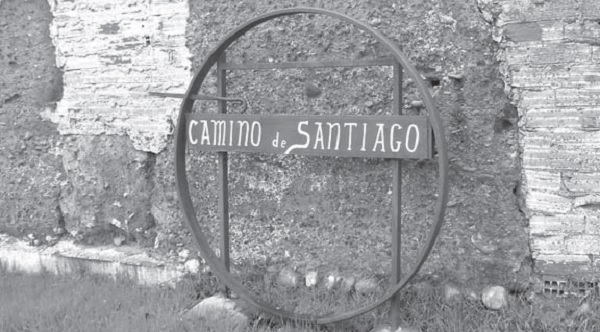
▲Road sign on the Camino de Santiago pilgrimage route in Spain.
Pilgrims are more serious about their search for purpose and answers than the average college backpacker traveling across Europe. The age of the pilgrims in 50%, both past and present, is between thirty-five and sixty-five years old, and most of them are in a stage of change in work, relationships, or studies. They come from a variety of spiritual backgrounds and hope to find the time and space to deal with these issues and seek answers to these profound questions.
Together, Nader and I felt God calling us to join an international team that provides hospitality and care to pilgrims on the Camino de Santiago. It was a place where our past studies at Wheaton and Trinity Theological Seminary, as well as our experiences as backpackers and youth hostel workers, blended perfectly; and we felt that God had given us the past few years to not only fall in love with the travel subculture and Spiritual Seekers, and provide us with organized training and complete formal preparation in this world.
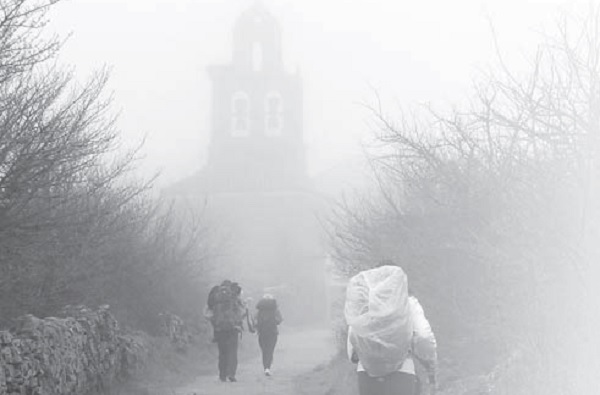
▲In the heavy fog, backpackers still walked firmly and silently towards the cathedral, the end of the pilgrimage.
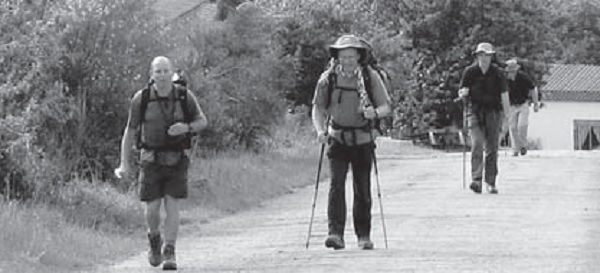
▲People have been walking there since 800 AD, and millions of pilgrims have walked this road throughout history.
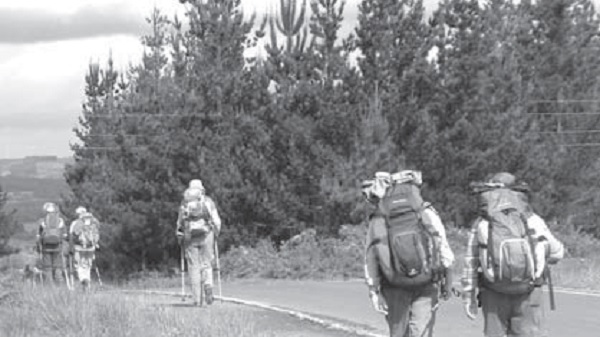
▲In modern times, many backpackers also embark on this pilgrimage.
medium range expansion
In September 2007 we moved to Spain to work as international staff in the international team. At that time we already had three children, Brennan, Ryan, and Kathryn. What followed was a long process of study and planning: learning Spanish, completing thousands of document preparations, researching pilgrim routes and pilgrim information, and developing business plans. We also cooperated with the local Spanish church to register a new non-profit organization: Terra Nova (meaning "New Earth"). A few years later, the fourth child, Wen Qingxiu (Matthew), was born, and our family expanded. From 2012 to 2013, a total of four new full-time team members joined, and our team also expanded.
Nader and I also had the opportunity to walk part of the pilgrimage route. On my pilgrimage I met a pilgrim from Sweden named Annette. She told me that her two-and-a-half-year-old son had died ten years ago and that she had not had any other children since then. Since then, Annette has made an annual pilgrimage in memory of her son. We chatted for an hour or two, and I listened most of the time. Her story is very touching. She still looks forward to her son coming back (of course), and there is another thing that is also tormenting her, that is, she and her husband decided to divorce years ago, ending their thirty-year marriage. Annette's words were full of sadness and loneliness. She embarked on the pilgrimage this year in the midst of a huge change in her life.
Annette is not alone in this experience. Some pilgrims carry very heavy emotional burdens and truly need peace, healing, and purpose in life. Psalm 34:18:“The Lord is near to the brokenhearted, and saves those who are crushed in spirit.”The personal experience of the pilgrimage route is a confirmation of our call to care for pilgrims. At the same time, we also feel that we need a place at the end of the pilgrimage route (Santiago de Compostela) to provide both life and spiritual life for pilgrims. actual needs.
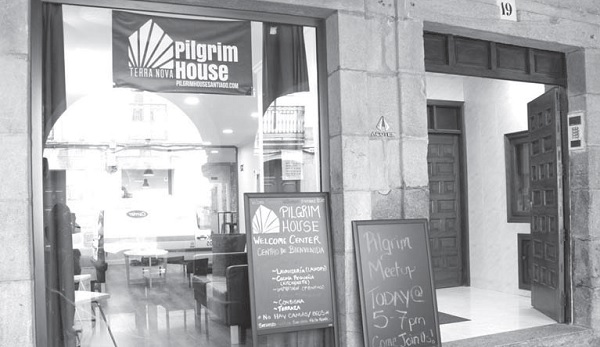
▲The warm and bright entrance of "Pilgrim's House".
Pilgrim House Welcome Center
In July 2014, after years of hard preparation, our team finally ushered in the opening day of the "Pilgrim House Welcome Center" and received the first batch of pilgrims! We learned that once the pilgrims reach Santiago after walking 100 to 800 kilometers (or more) on the pilgrimage route, what they most want to do is celebrate. From the first day we opened, our team has worked hard to welcome and greet every pilgrim, ask him/her his/her name, and say to him/her: "Congratulations! You arrived in Santiago! That's great!" In addition to this important welcome As an opening statement, we also designed the "Pilgrim House" as a place where pilgrims can dialogue, communicate, and pray. The living room and kitchenette are places where pilgrims gather and chat; at the end of the corridor there is a meditation room and a terrace where pilgrims can write notes, read books or Bibles provided by our library, or pray. The actual services we provide are: laundry, printing of boarding passes, coffee or tea, and luggage storage.
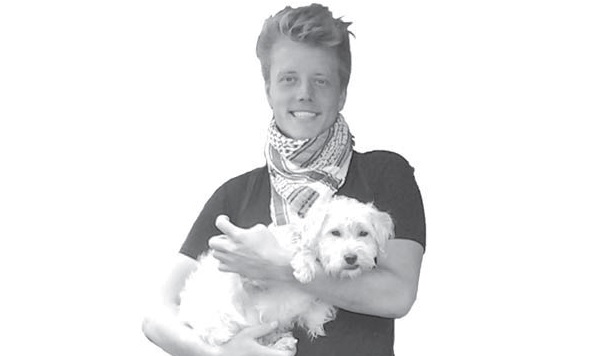
▲Jordy, a young pilgrim from the Netherlands.
The weekly "meeting times" for pilgrims are Mondays and Thursdays. This is a time for them to "bump into each other", get to know each other better and share their pilgrimage experiences. Jordi was a pilgrim from the Netherlands who walked to Santiago. He always made us feel welcome. During one meeting, another pilgrim shared Psalm 139. Jodi asked, "What is Psalm 139? Is there a Bible here? I want to read it." We immediately went to the Pilgrim Library and took out an English Bible and a Dutch Bible. Jodi had never read the Bible before, but with our help, he found Psalm 139 and read it aloud in Dutch. Then other pilgrims looked through their Bibles and read their favorite psalms—what a sacred moment!
Jordi spent the next three weeks in and around Santiago. He said he was seriously seeking God. In his own words, he walked the Camino de Santiago to learn more about Christianity. We had the opportunity to talk to him several times about Jesus’ behavior, and we also gave him a New Testament. We later learned that he and another pilgrim read the New Testament together every day while traveling outside Santiago. Finally it was time for him to return to the Netherlands. Nader prayed for him. Jordi was very grateful for all the time he spent at the "Pilgrim House". We are also very grateful to God for giving us the opportunity to participate in inviting Jordi more Learn more about Jesus and the Bible.
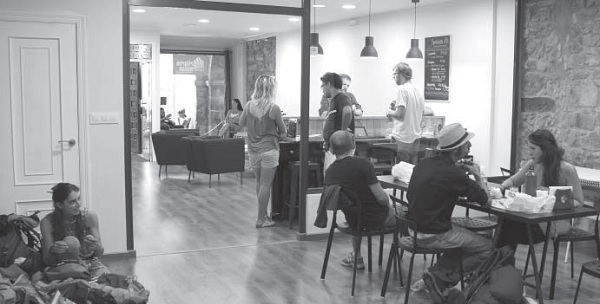
▲Many pilgrims find a restful place for body, mind and spirit here.
Hospitality and healing
Currently, as we spend more time with pilgrims, the more we see the good work God has already done in their lives. Our job is to take care of their needs, listen to their stories, tell them our own experiences of knowing God and experiencing God, so that they can understand everything God has revealed in their hearts. As we truly engage in hospitality, deeper themes and principles of hospitality emerge. In his masterpiece "Outreach Care" (see notes at the end of the article), Henry Lewin talks about hospitality and healing:
Healing, therefore, means first and foremost the creation of an empty but friendly space where those who are suffering can tell their stories to someone who will really listen. Listening is an art that must be developed, not a skill that can be applied...The healer is the moderator, listening patiently and carefully to the stories of the experiences of strangers in trouble. (pages 95 to 96)
We had never thought of the connection between healing and listening, and that listening is so closely related to hospitality. But we do see that when pilgrims have the space and time to deeply share their sufferings, they seem to become more peaceful afterwards. Perhaps it’s because they have been relieved of their burdens and are beginning to taste the rest that Jesus offers.
Henri Nouwen also talked about head-on conflict. The meaning of this conflict does not refer to disputes or conflicts, but to the host simply being himself/herself and expressing an existence.
If we really want to be hospitable, we must not only receive strangers, but also make your presence known to them unmistakably, not by hiding behind a neutral perspective, but by expressing clearly and unmistakably our views, opinions, and lifestyle. There can be no real dialogue between someone and no one. Only when our life choices, attitudes and perspectives can provide boundaries for strangers, challenge the other person to realize where they stand and engage in critical discussion, can we enter into true communication and communication. (page 99)
This principle applies to everyone in our lives who needs hospitality, not just pilgrims. We obey the leading of the Holy Spirit. When we get along with pilgrims, we accompany them wholeheartedly, share our own opinions and experiences, and let the Holy Spirit remind and illuminate the other person's position; if necessary, we also bring healing into the other person's body. life.
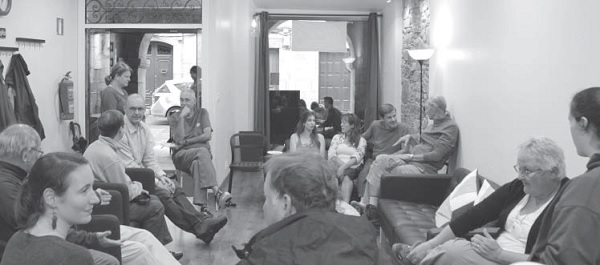
▲The living room and kitchenette of the "Pilgrim House" are places where travelers gather, chat, communicate, and pray.
The pilgrimage continues
In early December 2014, a group of five American college students walked into our center after trekking for four days on the pilgrimage. One of the girls had injured her foot earlier and was unable to walk with her backpack on. So for the rest of the trip, the two boys took turns carrying her backpack. Although carrying a backpack for a friend is hard work and slows them down, it saves her the burden because it helps her and they are happy while carrying the backpack. I admire the attitude of these two boys: their sacrificial love and kindness are very touching.
We hope to continue to hear and see stories like this at Pilgrim House. As mentioned before, we know that God is already at work in their lives, and we are honored to be at the end of the pilgrimage to congratulate the pilgrims, celebrate with them, and help them continue their pilgrimage spiritually. In addition, Martin Sheen's 2010 film "The Way" has also had a great impact on us, because the number of pilgrims from the United States and Canada has increased significantly in the past few years (a record number of pilgrims in 2013) More than 10,000 Americans completed the pilgrimage). We found it wonderful to have the privilege of hosting male and female visitors from home in a foreign country, and I personally enjoyed interacting with pilgrims of Chinese background. Last week, I met a Hong Konger who now lives in the UK. When she learned that we were both Hakkas, she screamed with joy and gave me a big hug! Hakka people in Taiwan may not be big on hugging, but when they get together in Spain, they definitely do! (In fact, the word "Hakka" is pronounced Hagga in Hakka, which sounds like "Hug God" in English!)
Looking back at the summer of 1996, I'm glad I didn't give in to my laziness and pack everything up and get myself on the plane. Nowadays, it is a dream come true whenever I see twenty to thirty pilgrims in the Pilgrim House: some are chatting with each other, some with us, some are reading in the hut, and some are cooking. Make coffee or write notes. Scenes like this are what Pilgrim House exists for! To paraphrase what writer Andy Stanley said: "Once God starts, He mobilizes all things." After embarking on this journey, we have experienced one milestone after another and witnessed it again and again. This sentence.

▲Wynnard and Nate & Faith Walter warmly welcome guests.
Invite you to be a pilgrim
If you are interested in the pilgrimage, let yourself become a pilgrim! Live like a pilgrim for a week or more. It's not easy, but once your life is pared down to its essentials, you will find a freedom when you create space for yourself to think and pray, to process your own journey, to listen to the stories of other pilgrims, and to share your own life. feel. Sometimes embarking on the pilgrimage road is fun and relaxing, but once you embark on it, you must dig deeply and explore to complete the day's itinerary. You can make deep connections with other pilgrims while walking on the pilgrimage road, and you also have time to stay in a hostel. Together, there are many opportunities to take care of each other and share with each other.
We also hope that volunteers can commit themselves to serve at the Pilgrim Home for one week to three months at a time. The conditions for becoming a volunteer are: having walked at least 100 kilometers on the pilgrimage route before applying to join.
Note:
‧ Henri Nouwen, Reaching Out: The Three Movements of the Spiritual Life, New York, Doubleday, 1986.
Camino de Santiago
Celtic daily prayer:
“May the peace of the Lord Christ be with you wherever He sends you.
May He guide you through the wilderness and protect you through the storms.
May He lead you home happy and filled with the miracles He has given you.
May He lead you home happily and walk through our door again. "
The Camino de Santiago refers to the pilgrimage to the tomb of the apostle James, son of Zebedee and brother of John. Legend has it that James was buried on the site of the cathedral in Santiago de Compostela. Pilgrims have been walking to Santiago since AD 800, and historians say that millions of pilgrims have walked this pilgrimage route since then. Along with the pilgrimages to Rome and Jerusalem, this is one of the most important pilgrimages of the Catholic Church. There is not just one pilgrimage route, but many routes starting from all over Europe, and pilgrims can walk or cycle for weeks or months to finally reach Santiago.
The Camino de Santiago pilgrimage has become increasingly popular in recent years. The number of pilgrims arriving in Santiago in 2003 was 74,614. Ten years later, 215,880 pilgrims arrived in 2013. They come from 156 different countries, including 431 from mainland China and 88 from Taiwan.
Most of those who embarked on the pilgrimage in the Middle Ages were devout Catholics. Today, there are people of various faiths and cultural backgrounds who embark on the pilgrimage for various reasons. Some people do it because they need to urgently streamline their modern lives and detach themselves from and deal with the deeper problems in life. Some people simply want to experience nature, while others want to experience Spanish history and culture. There are also many people who are experiencing huge changes and even losses in their lives and need space to process the past chapters before moving on to the next chapter of their lives. When they arrived in Santiago and walked into the Pilgrim Affairs Office to receive the completion certificate, 95% mentioned the word "religion" when describing the source of motivation for the pilgrimage, at least part of the reason. For many pilgrims, walking the pilgrimage remains a profound spiritual experience.
The most popular route is the Camino Francés, which starts in St. Jean Pied-de-Port, France and covers a total length of more than 800 kilometers (500 miles). Many pilgrims walk for a month to complete the journey.
Please pray and support
We would like to have more paperback versions of the Gospel of John or the New Testament in different languages to give away to pilgrims.
Please join us in praying for:
‧Serve and take care of each pilgrim with wisdom
‧Have good relations with the local community
‧Healthy team communication and dynamics
‧Be prepared for the upcoming peak season (expected from March to October 2015)
Contact/Donation Information
(our blog and newsletter)
www.pilgrimhousesantiago.com
www.thesweetroad.com
www.iteams.org
 Author profile
Author profile
Faith Wen Walter graduated from Wheaton University and Trinity Evangelical Divinity School in Illinois. She and her husband Nate Walter engaged in pilgrim evangelism ministry in Spain. They have three sons and one daughter.
